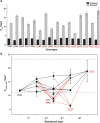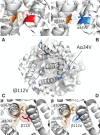Stability-Mediated Epistasis Restricts Accessible Mutational Pathways in the Functional Evolution of Avian Hemoglobin
- PMID: 28201714
- PMCID: PMC5400398
- DOI: 10.1093/molbev/msx085
Stability-Mediated Epistasis Restricts Accessible Mutational Pathways in the Functional Evolution of Avian Hemoglobin
Abstract
If the fitness effects of amino acid mutations are conditional on genetic background, then mutations can have different effects depending on the sequential order in which they occur during evolutionary transitions in protein function. A key question concerns the fraction of possible mutational pathways connecting alternative functional states that involve transient reductions in fitness. Here we examine the functional effects of multiple amino acid substitutions that contributed to an evolutionary transition in the oxygenation properties of avian hemoglobin (Hb). The set of causative changes included mutations at intradimer interfaces of the Hb tetramer. Replacements at such sites may be especially likely to have epistatic effects on Hb function since residues at intersubunit interfaces are enmeshed in networks of salt bridges and hydrogen bonds between like and unlike subunits; mutational reconfigurations of these atomic contacts can affect allosteric transitions in quaternary structure and the propensity for tetramer-dimer dissociation. We used ancestral protein resurrection in conjunction with a combinatorial protein engineering approach to synthesize genotypes representing the complete set of mutational intermediates in all possible forward pathways that connect functionally distinct ancestral and descendent genotypes. The experiments revealed that 1/2 of all possible forward pathways included mutational intermediates with aberrant functional properties because particular combinations of mutations promoted tetramer-dimer dissociation. The subset of mutational pathways with unstable intermediates may be selectively inaccessible, representing evolutionary roads not taken. The experimental results also demonstrate how epistasis for particular functional properties of proteins may be mediated indirectly by mutational effects on quaternary structural stability.
Keywords: Caprimulgidae; epistasis; fitness landscape; hemoglobin; nightjars; pleiotropy.
© The Author 2017. Published by Oxford University Press on behalf of the Society for Molecular Biology and Evolution.
Figures






Similar articles
-
Epistasis constrains mutational pathways of hemoglobin adaptation in high-altitude pikas.Mol Biol Evol. 2015 Feb;32(2):287-98. doi: 10.1093/molbev/msu311. Epub 2014 Nov 18. Mol Biol Evol. 2015. PMID: 25415962 Free PMC article.
-
Epistasis among adaptive mutations in deer mouse hemoglobin.Science. 2013 Jun 14;340(6138):1324-7. doi: 10.1126/science.1236862. Science. 2013. PMID: 23766324 Free PMC article.
-
Negative Epistasis in Experimental RNA Fitness Landscapes.J Mol Evol. 2017 Dec;85(5-6):159-168. doi: 10.1007/s00239-017-9817-5. Epub 2017 Nov 10. J Mol Evol. 2017. PMID: 29127445 Review.
-
The role of mutation bias in adaptive molecular evolution: insights from convergent changes in protein function.Philos Trans R Soc Lond B Biol Sci. 2019 Jul 22;374(1777):20180238. doi: 10.1098/rstb.2018.0238. Epub 2019 Jun 3. Philos Trans R Soc Lond B Biol Sci. 2019. PMID: 31154983 Free PMC article.
-
Causes of molecular convergence and parallelism in protein evolution.Nat Rev Genet. 2016 Apr;17(4):239-50. doi: 10.1038/nrg.2016.11. Epub 2016 Mar 14. Nat Rev Genet. 2016. PMID: 26972590 Free PMC article. Review.
Cited by
-
Genotype networks of 80 quantitative Arabidopsis thaliana phenotypes reveal phenotypic evolvability despite pervasive epistasis.PLoS Comput Biol. 2020 Aug 13;16(8):e1008082. doi: 10.1371/journal.pcbi.1008082. eCollection 2020 Aug. PLoS Comput Biol. 2020. PMID: 32790763 Free PMC article.
-
High-Altitude Adaptation: Mechanistic Insights from Integrated Genomics and Physiology.Mol Biol Evol. 2021 Jun 25;38(7):2677-2691. doi: 10.1093/molbev/msab064. Mol Biol Evol. 2021. PMID: 33751123 Free PMC article. Review.
-
Evolved increases in hemoglobin-oxygen affinity and the Bohr effect coincided with the aquatic specialization of penguins.Proc Natl Acad Sci U S A. 2021 Mar 30;118(13):e2023936118. doi: 10.1073/pnas.2023936118. Proc Natl Acad Sci U S A. 2021. PMID: 33753505 Free PMC article.
-
Evolution and molecular basis of a novel allosteric property of crocodilian hemoglobin.Curr Biol. 2023 Jan 9;33(1):98-108.e4. doi: 10.1016/j.cub.2022.11.049. Epub 2022 Dec 21. Curr Biol. 2023. PMID: 36549299 Free PMC article.
-
Ensemble epistasis: thermodynamic origins of nonadditivity between mutations.Genetics. 2021 Aug 26;219(1):iyab105. doi: 10.1093/genetics/iyab105. Genetics. 2021. PMID: 34849909 Free PMC article.
References
-
- Arnone A, Perutz MF.. 1974. Structure of inositol-hexaphosphate-human deoxyhaemoglobin complex. Nature 249:34–36. - PubMed
-
- Baldwin J, Chothia C.. 1979. Haemoglobin: the structural changes related to ligand binding and its allosteric mechanism. J Mol Biol. 129:175–220. - PubMed
-
- Bellelli A, Brunori M, Miele AE, Panetta G, Vallone B.. 2006. The allosteric properties of hemoglobin: insights from natural and site directed mutants. Curr Protein Pept Sci. 7:17–45. - PubMed
Publication types
MeSH terms
Substances
Grants and funding
LinkOut - more resources
Full Text Sources
Other Literature Sources

